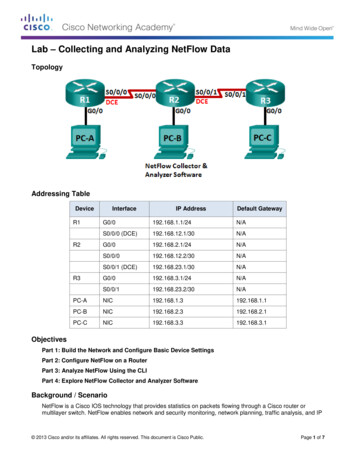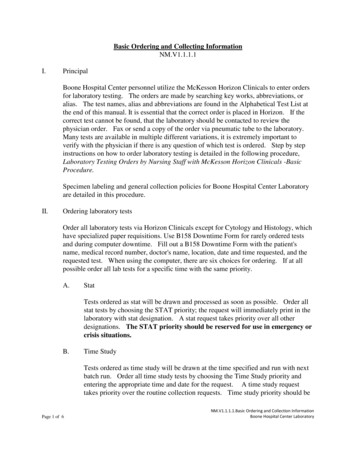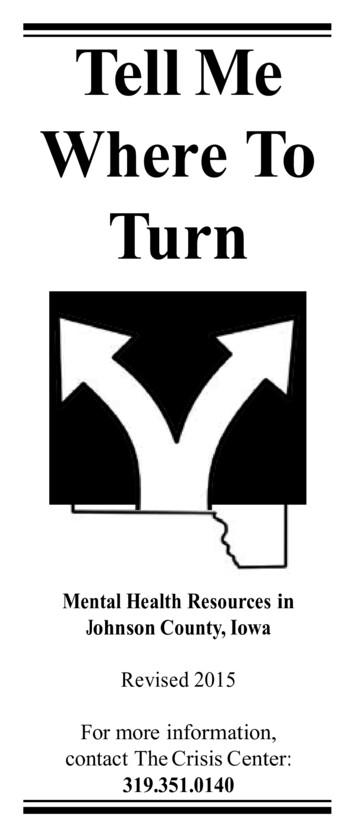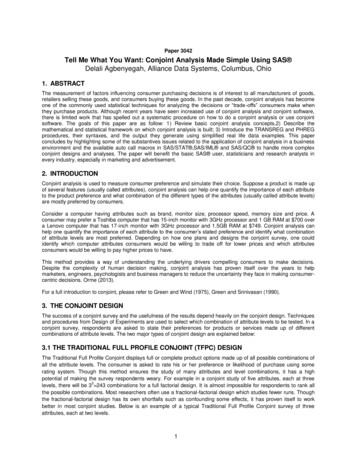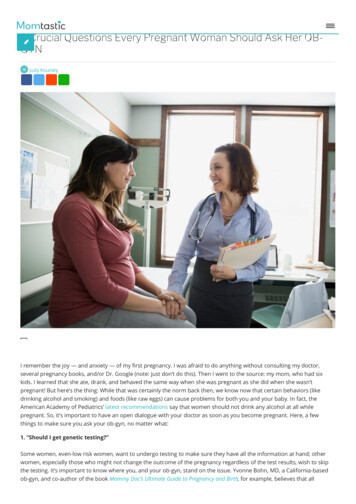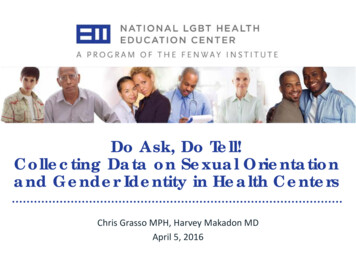
Transcription
Do Ask, Do Tell!Collecting Data on Sexual Orientationand Gender Identity in Health CentersChris Grasso MPH, Harvey Makadon MDApril 5, 2016
Continuing Medical EducationDisclosure Program Faculty: Harvey Makadon, MD Current Position: Director of Education and Training, The Fenway Instiute Disclosure: No relevant financial relationships. Presentation does not includediscussion of off-label products. Program Faculty: Chris Grasso, MPH Current Position: Associate Director for Informatics & Data Services, The FenwayInstitute Disclosure: No relevant financial relationships. Presentation does not includediscussion of off-label products.It is the policy of The National LGBT Health Education Center, Fenway Health that all CME planningcommittee/faculty/authors/editors/staff disclose relationships with commercial entities upon nomination/invitation of participation.Disclosure documents are reviewed for potential conflicts of interest and, if identified, they are resolved prior to confirmation ofparticipation. Only participants who have no conflict of interest or who agree to an identified resolution process prior to theirparticipation were involved in this CME activity.
Learning Objectives1. Describe LGBT health disparities, concepts, andterms2. Identify ways to provide a welcoming and inclusivehealth care environment to collect SO/GI data3. Explain why collecting sexual orientation and genderidentity (SO/GI) data is important for health centersand patient care4. Access recommendations for collecting sexualorientation and gender identity data and entering itinto electronic health records (EHR)www.lgbthealtheducation.org3
www.lgbthealtheducation.org5
www.lgbthealtheducation.org6
www.lgbthealtheducation.org7
www.lgbthealtheducation.org8
Introduction Lesbian, gay, bisexual, and transgender (LGBT) patientshave unique health needs and experience numeroushealth disparities They are an underserved population that is largelyinvisible in the health care system Routine and standardized collection of sexualorientation and gender identity (SOGI) information inelectronic health records (EHRs) will help assessaccess, satisfaction with, quality of care, inform thedelivery of appropriate health services, and begin toaddress health disparitieswww.lgbthealtheducation.org9
Stigma, Discrimination and HealthStigmaInterpersonalStructuralIntrapersonal StigmaStress/Anxiety/DepressionHealth Disparities/InequitiesHatzenbuehler, ML, Link, BG. 2014www.lgbthealtheducation.org10
Effects of Stigma on Health Internalized homophobia, experiencing discrimination,and expectations of rejection, were associated withHIV risk behavior (Hatzenbuehler, Nolen-Hoeksema, &Erickson, 2008) Enacted and anticipated stigma resulted inapproximately a 40% increase in delaying neededurgent and preventive care in a sample of 2,578 FTMtrans masculine people. (Reisner et. al. 2015)www.lgbthealtheducation.org11
Health Issues Throughout the LifeCourseChildhood &AdolescenceEarly & on.org12
LGBT Disparities: Healthy People2020 LGBT youth 2 to 3 times more likely to attempt suicide More likely to be homeless (20-40% are LGBT) Risk of HIV, STIs MSM are at higher risk of HIV/STIs, especially amongcommunities of color LGBT populations have the highest rates of tobacco,alcohol, and other drug use Lesbians and bisexual women are less likely to getpreventive screenings for cancerwww.lgbthealtheducation.org13
LGBT Disparities: Healthy People2020 Transgender individuals experience a high prevalenceof HIV/STIs, hate crimes, behavioral health issues, andsuicide They are also less likely to have health insurance thanheterosexual or LGB individuals Elderly LGBT individuals face additional barriers tohealth because of isolation, fewer family supports, anda lack of social and support serviceswww.lgbthealtheducation.org14
Who are LGBT People?www.lgbthealtheducation.org15
Understanding LGBT People It is important for health care providers to understandwho are LGBT people and to have a commonunderstanding of terms and definitions This allows for effective and respectful communicationand the delivery of culturally competent care Health care providers will be better equipped to servetheir patients and LGBT communities L,G,B,T people are a very diverse group with manyunique issues, and many common bondswww.lgbthealtheducation.org16
What’s in a Word?www.lgbthealtheducation.org17
Sexual Orientation and GenderIdentity are Not the Same All people have a sexual orientation and genderidentity How people identify can change Terminology varies Gender Identity Sexual Orientationwww.lgbthealtheducation.org18
Sexual Orientation Sexual orientation: how aperson identifies theirphysical and emotionalattraction to others DesireDimensions of SexualOrientation: Same sex attraction Behavior: Men who have sex with menMSM (MSMW) Women who have sex withwomen-WSW (WSWM) Identity: Straight, gay, lesbian, bisexual,queer--otherwww.lgbthealtheducation.org19
Gender Identity and GenderExpression Gender identity A person's internal sense of their gender (do I considermyself male, female, both, neither?) All people have a gender identity Gender expression How one presents themselves through their behavior,mannerisms, speech patterns, dress, and hairstyles May be on a spectrumwww.lgbthealtheducation.org20
www.lgbthealtheducation.org21
The T in LGBT: Transgender Transgender Gender identity not congruent with the assigned sex at birth Alternate terminology Transgender woman, trans woman, male to female (MTF) Transgender man, trans man, female to male (FTM) Trans feminine, Trans masculine Non-binary, genderqueer Gender identity is increasingly described as being on a spectrumwww.lgbthealtheducation.org22
Reviewing TerminologyGender Identity What your internal sensetells you your gender isSexual Orientation Whom you are physicallyand emotionally attracted to Whom you have sex with How you identify yoursexualitySex Refers to the presence ofspecific anatomy. Also maybe referred to as ‘AssignedSex at Birth’Gender Expression How you present yourgender to societythrough clothing,mannerisms, etc.23www.lgbthealtheducation.org23
Creating a Welcoming andInclusive Environment for Caring,Working and Learningwww.lgbthealtheducation.org24
Creating a Caring and InclusiveEnvironment Does your center have a nondiscrimination policy that includessexual orientation, gender identityand gender expression? Are clinicians and staff taught aboutthe health needs of LGBT people? Do LGBT employees feel respectedand safe at work? Do forms reflect the full range ofsexual and gender identity andexpression?www.lgbthealtheducation.org25
Avoiding Assumptions You cannot assume someone’s gender or sexual orientationbased on how they look or sound To avoid assuming gender or sexual orientation with newpatients: Instead of: “How may I help you, sir?”Say: “How may I help you?”Instead of: “He is here for his appointment.”Say: “The patient is here in the waiting room.”Instead of: “Do you have a wife?”Say: “Are you in a relationship?”Instead of: “What are your mother and fathers’ names?”Say: “What are your parents’ names.”www.lgbthealtheducation.org26
Do Ask, Do Tell: Talking to yourprovider about being LGBTwww.lgbthealtheducation.org27
Collecting SOGI Data in EHRswww.lgbthealtheducation.org28
IOM Reports The Health of LGBT People: Building aFoundation for Better Understanding(2011): “Data on sexual orientation andgender identity should be collected inelectronic health records.” Collecting SOGI Data in Electronic HealthRecords (2013): “ data collection shouldstart now to better understand the healthcare issues experienced by LGBT people.”www.lgbthealtheducation.org29
Collecting SOGI www.lgbthealtheducation.org30
Federal RegulatoryDevelopments Stage 3 Meaningful Use Guidelines According to CMS and ONC, SOGI data fields must beincorporated in EHR software certified under theMeaningful Use Incentive Program HRSA: Changes for CY 2016 UDS Reporting Improving the health of the nation’s underserved is apriority of the Health Center Program Sexual orientation and gender identity can play a significantrole in determining health outcomes Sexual Orientation and Gender Identity are reported on UDSTables 3A, 3Bwww.lgbthealtheducation.org32
Federal RegulatoryDevelopments CMS Equity Plan “Collection of standardized data is an important first steptowards improving population health.” “Comprehensive patient data, including sexual orientation,gender identity are required to plan for qualityimprovements, and to address changes among the targetpopulations over time.”www.lgbthealtheducation.org33
Preparation for Collecting Data inClinical Settings Clinicians: Need to learn about LGBT health and therange of expression related to identity, behavior, anddesire. Staff needs to understand concepts Non-clinical staff: Front desk and patient registrationstaff must also receive training on LGBT health,communicating with LGBT patients, and achievingquality care with diverse patient populations Patients: Need to learn about why it is important tocommunicate this information, and feel comfortablethat it will be used appropriatelywww.lgbthealtheducation.org34
How to Ask SOGI questions There are various ways SOGI information can beincorporated into the EHR and there is no singlesystem to achieve this SOGI questions can be asked on registration forms in thedemographics section Providers ask SOGI questions during patient visit Answers can be entered into an EHR directly by a patient ormember of the clinical staff, or transcribed at registrationwww.lgbthealtheducation.org35
Gathering LGBT Data During theProcess of CareConcept: Harvey Makadon, M.D. Created by: Komal Basrawww.lgbthealtheducation.org36
Collecting SOGI Information Priorto ArrivalConcept: Harvey Makadon, M.D. Created by: Komal Basrawww.lgbthealtheducation.org37
Self-Administered ComputerBased Questionnaires SOGI information can be entered into the EHR directlyby the patient through an online portal/mobile device This can occur at home prior to office visit There is the added benefit of additional privacy in answeringSOGI questions at home Self-administered Computer-based questionnaires canbe used to gather patient reported data Have the potential to elicit more accurate responses tosensitive questionswww.lgbthealtheducation.org38
Asking SOGI information onpatient registration (intake) formsConcept: Harvey Makadon, M.D. Created by: Komal Basrawww.lgbthealtheducation.org39
Collecting SOGI Data DuringOnsite Registration Patients should be asked standardized SOGI questionsas part of the demographic section on registration Questions can be included alongside otherdemographic questions (i.e. race, ethnicity, language) Patients should be informed that information will helphealth care providers to deliver appropriateprevention, screening, and treatment services SOGI information should be updated as needed on anongoing basis for both new and returning patients Patients must be assured information will be keptconfidentialwww.lgbthealtheducation.org40
Collecting Demographic Data onSexual Orientation (Example)www.lgbthealtheducation.org41
Collecting Data on GenderIdentity What is your current gender identity? Male Female Transgender Male/Trans Man/FTM Transgender Female/Trans Woman/MTF Gender Queer Additional Category (please specify)What is your preferred name, and whatpronouns do you use (e.g. he/him,she/her, they/them)? What sex were you assigned at birth? Male Female Decline to Answerwww.lgbthealtheducation.org42
Preferred Name and PronounsWhat is your preferred name What are your pronouns (e.g. he/him,she/her, they/them)? It is important to ask patients to include their preferred nameand their pronouns on registration forms Many transgender patients may have identification documentsand insurance forms that do not reflect their current name andgender identity Some patients may have a non-binary gender identity and usepronouns such as “they” or “ze”, which may be unfamiliar tosome providerswww.lgbthealtheducation.org43
Asking SOGI Questions Duringthe Clinical EncounterConcept: Harvey Makadon, M.D. Created by: Komal Basrawww.lgbthealtheducation.org44
Directly Asking SOGI Questions If patients leave SOGI questions unanswered onregistration forms, health care providers should re-askthese questions during the clinical encounter Sexual orientation, sexual behavior, gender identity,name and pronouns questions should be asked duringthe first clinical visit and on an ongoing basis asindicatedwww.lgbthealtheducation.org45
How Providers Can Ask SOGIQuestions Open-ended questions can allow patients to feelcomfortable to disclose SOGI information “Tell me a little bit about yourself” “Do you have any concerns or questions about your sexualorientation, sexual desires, or gender identity?” SOGI questions can also be asked during the social orsexual history during history taking Providers can normalize this process by saying “this issomething I ask all of my patients”www.lgbthealtheducation.org46
Challenges Associated withAsking SOGI Questions Patient concerns regarding privacy and confidentiality This may limit patient disclosure of SOGI information Critical to develop adequate standards for encoding medicalinformation and computer infrastructure to manage threatsto privacy Provider-reported concerns regarding lack of comfortin asking SOGI questions Time constraints during the clinic visit Despite concerns regarding time constraints, it is importantfor providers to discuss these issues to adequately care forLGBT patientswww.lgbthealtheducation.org47
Beyond Data Collection:Systems that Facilitate Getting itRight Decision Support Coding Reimbursementwww.lgbthealtheducation.org48
Preventive Health Screenings Charles M is a 35-year-old malewho presents with symptoms ofburning on urination andurethral discharge At first he said he is straight, buton further questioning, he saidhe occasionally has unprotectedsex with other men Given history, he will needrepeat HIV testing, assessmentof risk behaviors and STIscreeningwww.lgbthealtheducation.org49
Appropriate Screening: Jake R’sStory Jake R is a 45-year-old man who camein with pain and on x-ray whatappeared to be metastases from aunknown primary cancer Evaluation ultimately showed that hehad developed cancer in his residualbreast tissue after surgery to removehis breasts No one told Jake that he neededroutine breast cancer screening, eventhough his mother and sister also hadbreast cancerwww.lgbthealtheducation.org50
Louise M Louise M is a 59-year-old womanwho developed a high fever andchills after head and neck surgery The source of infection was herprostate gland (acute prostatitis),but no one knew that she had thisanatomy No one asked her about her genderidentity or knew she wastransgender She had never had prostatescreeningwww.lgbthealtheducation.org51
Decision Support Decision support in the form of alerts and remindersmust be built into the EHR system in order to remindHCPs to conduct indicated preventive screenings Decision support systems for transgender patientsshould be based on assigned sex at birth and an up-todate anatomical inventory For example, a transgender man may retain his cervix andmay need a Pap testwww.lgbthealtheducation.org52
Transgender Patients: Organs forInventory It is important for clinicians to maintain an up-to-dateanatomical inventory, which will direct any indicatedpreventive screeningswww.lgbthealtheducation.org53
Coding and Reimbursementwww.lgbthealtheducation.org54
Transgender Health and Coding A transgender man may be registered in the EHR system undera male name and gender If the patient has a cervix, uterus, and ovaries, providers will require theability to enter gynecological history and pelvic physical exam findings May need to order a Pap test through the EHR system EHR templates that use pre-populated fields may preventproviders from entering a gynecological history and physicalexam findings This ultimately may create billing difficulties and a failure to bereimbursed for the provision of indicated health serviceswww.lgbthealtheducation.org55
Addressing Coding andReimbursement Issues Adequate EHR coding mechanisms must be in place toaccurately document LGBT health information and billfor health services Must engage health insurance providers about LGBTstandards of care Necessary so that indicated health services are routinelycovered by insurance providers The lack of transgender specific health codes oftenresults inappropriate denials of services renderedwww.lgbthealtheducation.org56
Challenges in Coding:Transgender HealthICD-10Gender DysphoriaAdults/AdolescentsF64.1Gender DysphoriaChildrenF64.2Hormone DisturbanceNOSE34.9Preventive Health: PAP,Prostate, Breast, Etc.With or without change in legalgender?Gender/Body DivergenceVs. Gender IncongruenceConsideration but must beremoved from mental healthchapterwww.lgbthealtheducation.orgICD-11?57
Where the rubber meets theroad: Our experienceswww.lgbthealtheducation.org58
Starting the Process Create your Team Include key staff who can be champions and provide feedback Management/Department Directors, Clinical Staff, Non-Clinical Staff, HIT Staff Senior Management Support Training Clinical Staff (e.g. MD, Medical Assistants, Nurses, Optometrists, Dentists) Non-Clinical staff (e.g. Front desk/Patient Services, Billing) Don’t neglect non-clinical staff Privacy and Confidentiality Pilot the process Start with one location or floor Start with one department Choose front desk/patient services staff who are champions Frequent check-ins with staff piloting the process PDSA Consider using this process to implement and monitor data collectionwww.lgbthealtheducation.org59
Starting the Process (cont’d) EHR CustomizationCreate structured and discrete data fieldsLimit ability to free text responses into the fieldDifferentiate between default values and missing/unknown valuesPlacement of data fields and how data will be stored/enteredIncorporate necessary elements of a data collection (i.e. responsecategories, data fields, decision support) Access to SOGI information Does staff have EHR permission to enter , modify or view data? Creating or editing new templates/intake formswww.lgbthealtheducation.org60
Providing Information to Patientswww.lgbthealtheducation.org61
Sample Registration Intake Form Legal Name Preferred Name Pronouns Used Legal Sex Sexual Orientation Gender Identity Assigned Sex atBirthwww.lgbthealtheducation.org62
ion.org63
Task and Workflow Issueswww.lgbthealtheducation.org64
Pronoun Color CodeFemale Pronouns, e.g. She/Her/HersMale Pronouns, e.g. He/Him/HisNon-binary Pronouns, e.g. They/Them/Theirwww.lgbthealtheducation.org65
Current Practice: CPS RegistrationScreenwww.lgbthealtheducation.org66
Current Practice RegistrationScreenwww.lgbthealtheducation.org67
Current Practice: Modified ChartView2131www.lgbthealtheducation.org68
Custom Formswww.lgbthealtheducation.org69
Additional Customizations All letter templates updated to exclude salutations (e.g. Mr.,Miss, Ms.) Changed to ‘Dear Fenway Patient’ Clinicians can still edit the letters as needed Note: changes were made as legally permitted Added preferred name to other documents such as: Patient Instructions Internal labels Chart Summary Bulk mailings are reviewed to determine the correct name Consideration given to name patie
Apr 05, 2016 · Stage 3 Meaningful Use Guidelines According to CMS and ONC, SOGI data fields must be incorporated in EHR software certified under the Meaningful Use Incentive Program HRSA: Change


